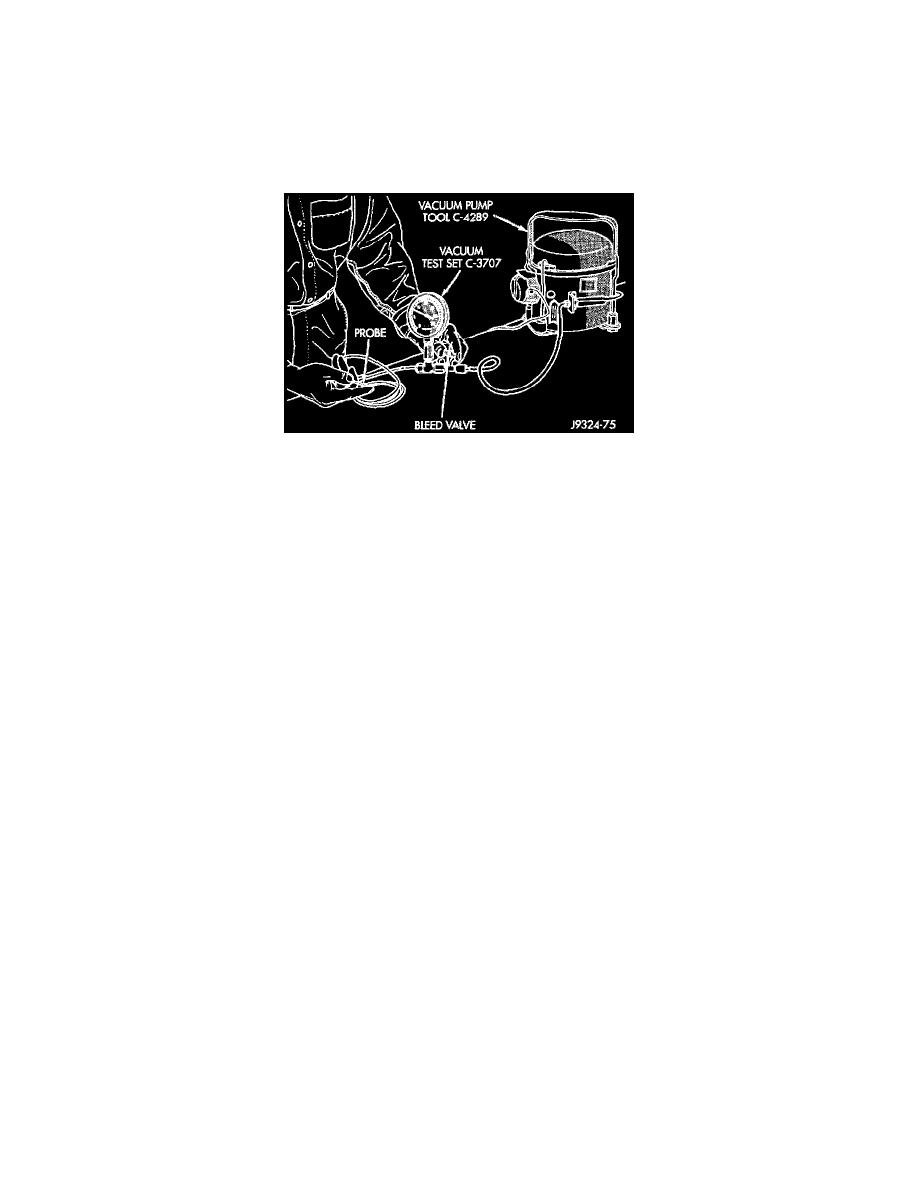Durango 4WD V8-5.9L VIN Z (1998)

Vacuum Check Valve HVAC: Testing and Inspection
Vacuum control is used to operate the mode doors in the heater-A/C housing. Testing of the heater-A/C mode control switch operation will determine if
the vacuum, electrical, and mechanical controls are functioning. However, it is possible that a vacuum control system that operates perfectly at engine
idle (high engine vacuum) may not function properly at high engine speeds or loads (low engine vacuum). This can be caused by leaks in the vacuum
system, or by a faulty or improperly installed vacuum check valve.
A vacuum system test will help to identify the source of poor vacuum system performance or vacuum system leaks. Before starting this test, stop the
engine and make certain that the problem is not a disconnected vacuum supply tube at the engine vacuum source or at the vacuum reservoir.
Adjust Vacuum Test Bleed Valve
Use an adjustable vacuum test set (Special Tool C-3707) and a suitable vacuum pump to test the heater-A/C vacuum control system. With a finger placed
over the end of the vacuum test hose probe, adjust the bleed valve on the test set gauge to obtain a vacuum of exactly 27 kPa (8 in. Hg.). Release and
block the end of the probe several times to verify that the vacuum reading returns to the exact 27 kPa (8 in. Hg.) setting. Otherwise, a false reading will
be obtained during testing.
Vacuum Check Valve
1. Remove the vacuum check valve that is to be tested. The valves are located in the vacuum supply tube (black) at the power brake booster on the
left side of the engine compartment, and in the heater and air conditioner vacuum take-out of the vacuum supply tube in the engine compartment.
The vacuum check valve must be removed in order to perform the following tests. See Vacuum Check Valve in the Replacement for the
procedures.
2. Connect the test set vacuum supply hose to the heater-A/C control side of the valve. When connected to this side of the check valve, no vacuum
should pass and the test set gauge should return to the 27 kPa (8 in. Hg.) setting. If OK, go to step Step 4. If not OK, replace the faulty valve.
3. Connect the test set vacuum supply hose to the engine vacuum side of the valve. When connected to this side of the check valve, vacuum should
flow through the valve without restriction. If not OK, replace the faulty valve.
Heater-A/C Controls
1. Connect the test set vacuum probe to the heater-A/C vacuum supply (black) tube in the engine compartment. Position the test set gauge so that it
can be viewed from the passenger compartment.
2. Place the heater-A/C mode control switch knob in each mode position, one position at a time, and pause after each selection. The test set gauge
should return to the 27 kPa (8 in. Hg.) setting shortly after each selection is made. If not OK, a component or vacuum line in the vacuum circuit of
the selected mode has a leak. See Locating Vacuum Leaks in the Diagnosis and Testing.
CAUTION: Do not use lubricant on the switch ports or In the holes In the plug, as lubricant will ruin the vacuum valve In the switch. A drop of
clean water in the connector plug holes will help the connector slide onto the switch ports.
Locating Vacuum Leaks
WARNING: ON VEHICLES EQUIPPED WITH AIRBAGS, REFER TO AIR BAGS AND SEAT BELTS/AIR BAGS BEFORE
ATTEMPTING ANY STEERING WHEEL, STEERING COLUMN, OR INSTRUMENT PANEL COMPONENT DIAGNOSIS OR
SERVICE. FAILURE TO TAKE THE PROPER PRECAUTIONS COULD RESULT IN ACCIDENTAL AIRBAG DEPLOYMENT
AND POSSIBLE PERSONAL INJURY.
1. Disconnect the vacuum harness connector from the back of the heater-A/C mode control switch on the instrument panel.
